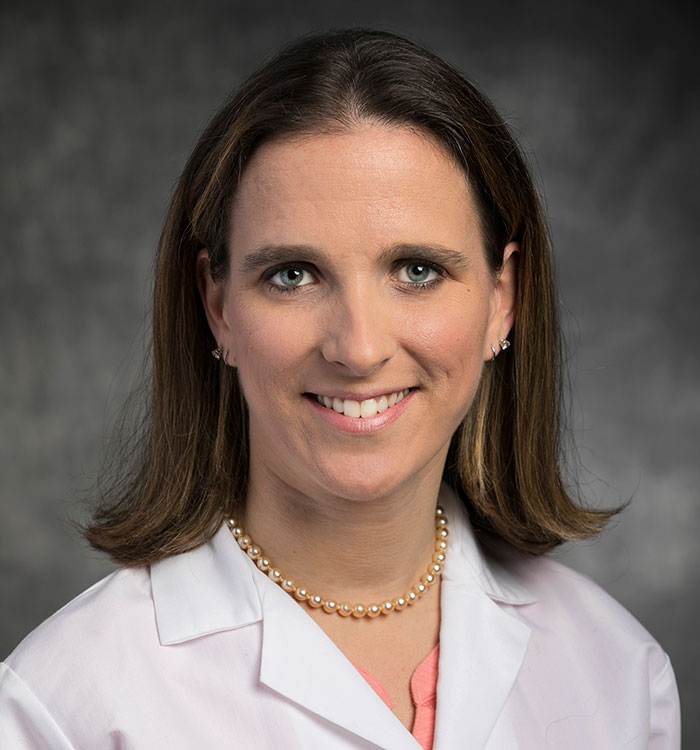Getting Crucial PM & R Services to Patients Who Need Them
July 21, 2021
Sarah Pastoriza, DO, recent winner of a “Dinner with the Doc” award, has been instrumental in more than quadrupling monthly PM & R consults at University Hospitals
UH Clinical Update | July 2021
Sarah Pastoriza’ s athletic skills were such that she easily went from being a softball player in high school to a javelin thrower during her time in college at the University of Florida, where she majored in engineering.
 Sarah Pastoriza, MD
Sarah Pastoriza, MDAnd it was injuring her rotator cuff in competition while throwing javelin that ended up shaping the kind of physician she would become. Two surgeries that she underwent to address that injury did little for her to return to throwing, and so she turned to physical medicine and rehabilitation (PM&R) for her own healing, and then professionally, to see if she could help others go back to their high-level of activity without surgery.
A native of Miami, Fla., she received her Doctor of Osteopathic Medicine (DO) from the Lake Erie College of Osteopathic Medicine in Bradenton, Fla. She then did her residency in PM&R at MetroHealth Medical Center and completed both an Interventional Orthopedics Fellowship and an Anesthesiology Pain Medicine Fellowship. She started her career this past summer in June of 2020 at University Hospitals.
Today, Dr. Pastoriza’s specialty covers inpatient rehabilitation, doing consults on inpatients at UH Cleveland Medical Center – especially those who have suffered spinal cord injury (SCI), traumatic brain injury (TBI) or strokes – and seeing outpatients at the newly expanded Comprehensive Pain Center at UH Parma Medical Center, as well as at her office in North Royalton.
Recently, she was one of seven physicians recognized as part of the new “Cliff Appreciates” initiative for caregivers who demonstrate an exceptional Commitment to Value or who have Advanced Systemness. Dr. Pastoriza was cited for expanding PM & R hospital consult services at UH, which resulted in visits increasing from 40 a month to more than 180 a month. She also was praised for networking with multiple referring services to provide additional care for some of the system’s most complex and disabled patients, including providing rehabilitation management and placement for SCIs, TBIs and strokes.
“What I find so gratifying about my work is that we don’t just treat one body part, as a physiatrist we take into consideration the patient as a whole and how can we help them function better - whether it’s knee pain or a stroke patient, our focus is on improving a patient’s quality of life,” she says. “I love to treat every patient like that, because each patient is unique.”
Dr. Pastoriza is looking to expand injection therapies in the Comprehensive Pain Center by offering Platelet-Rich Plasma (PRP) therapy, which means injecting a concentration of a patient's own platelets to accelerate the healing of injured tendons, ligaments, muscles and joints. So an individual patient's own healing system is used to improve musculoskeletal problems.
At the Comprehensive Pain Center, “I treat patients with all types of pain, from spine to peripheraI joints, along with seeing patients for weakness, gait instabilities and other issues that affect function.”
Patients there are treated with a variety of methods, which may include chiropractic care, psychological treatment for their pain, physical and occupational therapy, injections and/or infusion therapy. “We do everything we can to avoid prescribing opiates,” Dr. Pastoriza said. “For example, I had a patient who had been on Percocet for some time, and I prescribed Gabapentin for her, which turned out to be much more effective for her nerve pain.”
Doing manipulation of the spine or joints and taking a holistic approach to a patient suffering from pain is the foundation of osteopathy, which turned out to be key components of her education that resonated for her.
Dr. Pastoriza also does medical mission trips to Nicaragua annually where manipulation is all that can be offered for musculoskeletal or joint issues in patients, other than ibuprofen and Tylenol.
Whether here or there, though: “There is little that is more gratifying as a physician than to help people improve their pain, function and quality of life.”


